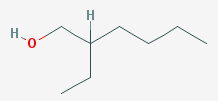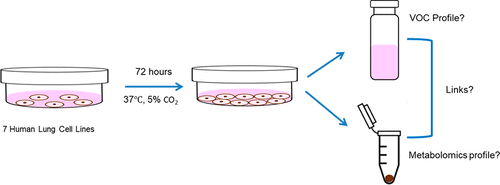Featured Image: Reproduced from Jia, Z.; Zhang, H.; Ong C.N.; Patra, A.; Lu, Y.; Lim, C.T.; Venkatesan T. Omega 2018, 3 (5), 5131-5140. Copyright 2018 American Chemical Society. Used with permission via AuthorChoice open access.
Title: Detection of Lung Cancer: Concomitant Volatile Organic Compounds and Metabolomic Profiling of Six Cancer Cell Lines of Different Histological Origins
Journal: Omega
Year: 2018
https://pubs.acs.org/doi/abs/10.1021/acsomega.7b02035
Breathe in… Breathe out… Did you know that the air from your lungs could potentially identify lung cancer? That’s right: scientist have identified molecules that can not only distinguish healthy lung tissue from cancerous lung tissue, but they can also determine what kind of cancer a patient has—which is critically important in deciding which treatments to use. And recently, scientists have been working on a method to collect these molecules from the air we breathe, instead of the current method of using painful and invasive biopsies to cut cells from the patient’s lungs.
The cells that line your lung tissue secrete molecules constantly, and some of these molecules are volatile, meaning they readily evaporate into the air. These evaporating molecules are called Volatile Organic Compounds, or VOCs. In a recent study, scientists grew cells descended from healthy lung tissue as well as four different types of lung cancer inside petri dishes. The scientists were able to collect the air above the cells, and use a technique called gas chromatography-mass spectroscopy (GC-MS) to identify the amount of each molecule in the sample. GC-MS works by first separating the molecules in the air by their physical properties, and then identifying each molecule by the mass of its atoms. This way, scientists could see whether certain types of lung cancer cells secreted a higher amount of certain molecules than other cancers or healthy lung cells did.
The experiment compared the healthy lung cells to the four types of cancer cells called “carcinomas”: small-cell carcinoma, large-cell carcinoma, squamous carcinoma, and adenocarcinoma. They found that three molecules were secreted at significantly higher levels in all cancer types tested than in the healthy cells: 2-methylpentane, 2-ethyl-1-hexanol, and 2,4-decadien-1-ol.



2-methylpentane 2-ethyl-1-hexanol 2,4-decadien-1-ol
They also found that 2-ethyl-1-hexanol and 2,4-decadien-1-ol, as well as a molecule called benzaldehyde, were found at much higher levels in large cell carcinoma than in either adenocarcinoma or squamous cell carcinoma.


Benzaldehyde Ethylbenzene
Additionally, small cell carcinoma could be distinguished from the other three types because it had higher levels of ethylbenzene as well as other molecules. This finding is especially important, since chemotherapy and radiation are effective treatments for small cell lung cancer, but surgery is usually required for the other three types.
Improving methods to detect lung cancer in its early stages is an especially important goal, since most lung cancers don’t present symptoms until they have progressed to stages 3 or 4, decreasing the five year survival rate down to only 10%. Having an early detection procedure that uses just the air from a patient’s lungs would be ideal, allowing people who may be at risk to be tested without painful and invasive procedures. And if evidence of cancer is found, identifying the type of cancer using the same method would allow doctors to decide on a course of treatment without needing additional testing.
This method still needs further development, though. The air from a person’s lungs is a more complicated mixture than the air from a single culture of multiple identical lung cells, as was tested in this study. Additionally, even two people with similar cancers might have different VOCs in their breath due to differences such as age, gender, diet, and other environmental factors like the kinds of pollution where they live. But with the successes seen so far, it’s promising that one day, diagnosing lung cancer could be as simple as breathe in…breathe out.
Molecular structures sourced from PubChem database:
https://pubchem.ncbi.nlm.nih.gov/compound/2-methylpentane#section=Top
https://pubchem.ncbi.nlm.nih.gov/compound/2-Ethylhexanol
https://pubchem.ncbi.nlm.nih.gov/compound/_2E_4E_-2_4-Decadien-1-ol
https://pubchem.ncbi.nlm.nih.gov/compound/benzaldehyde#section=Top
https://pubchem.ncbi.nlm.nih.gov/compound/ethylbenzene#section=Top

